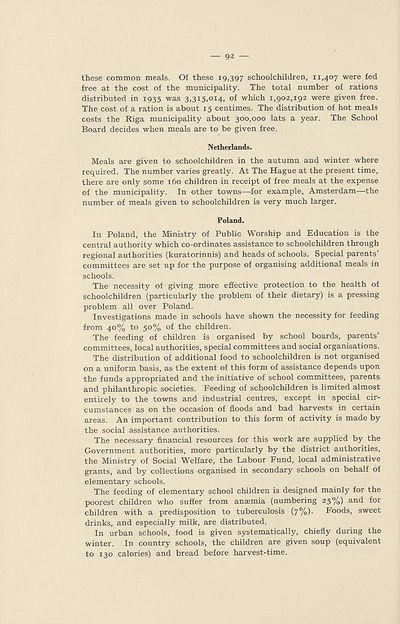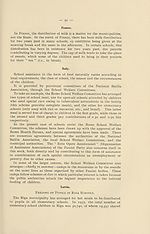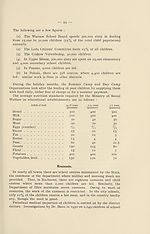Download files
Complete book:
Individual page:
Thumbnail gallery: Grid view | List view

— 92 —
these common meals. Of these 19,397 schoolchildren, 11,407 were fed
free at the cost of the municipality. The total number of rations
distributed in 1935 was 3,315,014, of which 1,902,192 were given free.
The cost of a ration is about 15 centimes. The distribution of hot meals
costs the Riga municipality about 300,000 lats a year. The School
Board decides when meals are to be given free.
Netherlands.
Meals are given to schoolchildren in the autumn and winter where
required. The number varies greatly. At The Hague at the present time,
there are only some 160 children in receipt of free meals at the expense
of the municipality. In other towns—for example, Amsterdam—the
number of meals given to schoolchildren is very much larger.
Poland.
In Poland, the Ministry of Public Worship and Education is the
central authority which co-ordinates assistance to schoolchildren through
regional authorities (kuratorinnis) and heads of schools. Special parents’
committees are set up for the purpose of organising additional meals in
schools.
The necessity of giving more effective protection to the health of
schoolchildren (particularly the problem of their dietary) is a pressing
problem all over Poland.
Investigations made in schools have shown the necessity for feeding
from 40% to 50% of the children.
The feeding of children is organised by school boards, parents’
committees, local authorities, special committees and social organisations.
The distribution of additional food to schoolchildren is not organised
on a uniform basis, as the extent of this form of assistance depends upon
the funds appropriated and the initiative of school committees, parents
and philanthropic societies. Feeding of schoolchildren is limited almost
entirely to the towns and industrial centres, except in special cir¬
cumstances as on the occasion of floods and bad harvests in certain
areas. An important contribution to this form of activity is made by
the social assistance authorities.
The necessary financial resources for this work are supplied by the
Government authorities, more particularly by the district authorities,
the Ministry of Social Welfare, the Labour Fund, local administrative
grants, and by collections organised in secondary schools on behalf of
elementary schools.
The feeding of elementary school children is designed mainly for the
poorest children who suffer from anaemia (numbering 25%) and for
children with a predisposition to tuberculosis (7%). Foods, sweet
drinks, and especially milk, are distributed.
In urban schools, food is given systematically, chiefly during the
winter. In country schools, the children are given soup (equivalent
to 130 calories) and bread before harvest-time.
these common meals. Of these 19,397 schoolchildren, 11,407 were fed
free at the cost of the municipality. The total number of rations
distributed in 1935 was 3,315,014, of which 1,902,192 were given free.
The cost of a ration is about 15 centimes. The distribution of hot meals
costs the Riga municipality about 300,000 lats a year. The School
Board decides when meals are to be given free.
Netherlands.
Meals are given to schoolchildren in the autumn and winter where
required. The number varies greatly. At The Hague at the present time,
there are only some 160 children in receipt of free meals at the expense
of the municipality. In other towns—for example, Amsterdam—the
number of meals given to schoolchildren is very much larger.
Poland.
In Poland, the Ministry of Public Worship and Education is the
central authority which co-ordinates assistance to schoolchildren through
regional authorities (kuratorinnis) and heads of schools. Special parents’
committees are set up for the purpose of organising additional meals in
schools.
The necessity of giving more effective protection to the health of
schoolchildren (particularly the problem of their dietary) is a pressing
problem all over Poland.
Investigations made in schools have shown the necessity for feeding
from 40% to 50% of the children.
The feeding of children is organised by school boards, parents’
committees, local authorities, special committees and social organisations.
The distribution of additional food to schoolchildren is not organised
on a uniform basis, as the extent of this form of assistance depends upon
the funds appropriated and the initiative of school committees, parents
and philanthropic societies. Feeding of schoolchildren is limited almost
entirely to the towns and industrial centres, except in special cir¬
cumstances as on the occasion of floods and bad harvests in certain
areas. An important contribution to this form of activity is made by
the social assistance authorities.
The necessary financial resources for this work are supplied by the
Government authorities, more particularly by the district authorities,
the Ministry of Social Welfare, the Labour Fund, local administrative
grants, and by collections organised in secondary schools on behalf of
elementary schools.
The feeding of elementary school children is designed mainly for the
poorest children who suffer from anaemia (numbering 25%) and for
children with a predisposition to tuberculosis (7%). Foods, sweet
drinks, and especially milk, are distributed.
In urban schools, food is given systematically, chiefly during the
winter. In country schools, the children are given soup (equivalent
to 130 calories) and bread before harvest-time.
Set display mode to:
![]() Universal Viewer |
Universal Viewer | ![]() Mirador |
Large image | Transcription
Mirador |
Large image | Transcription
Images and transcriptions on this page, including medium image downloads, may be used under the Creative Commons Attribution 4.0 International Licence unless otherwise stated. ![]()
| League of Nations > Economic and financial section > Problem of nutrition > (94) |
|---|
| Permanent URL | https://digital.nls.uk/190924984 |
|---|
| Shelfmark | LN.II |
|---|
| Description | Over 1,200 documents from the non-political organs of the League of Nations that dealt with health, disarmament, economic and financial matters for the duration of the League (1919-1945). Also online are statistical bulletins, essential facts, and an overview of the League by the first Secretary General, Sir Eric Drummond. These items are part of the Official Publications collection at the National Library of Scotland. |
|---|---|
| Additional NLS resources: |
|

